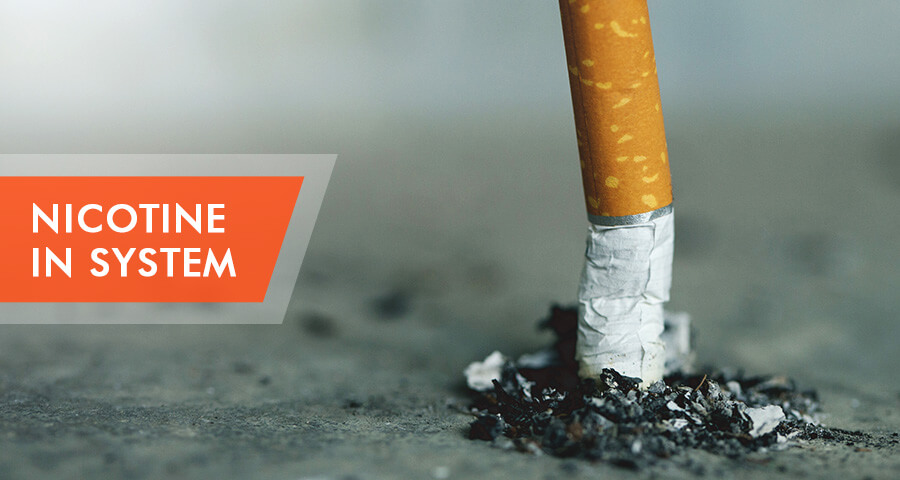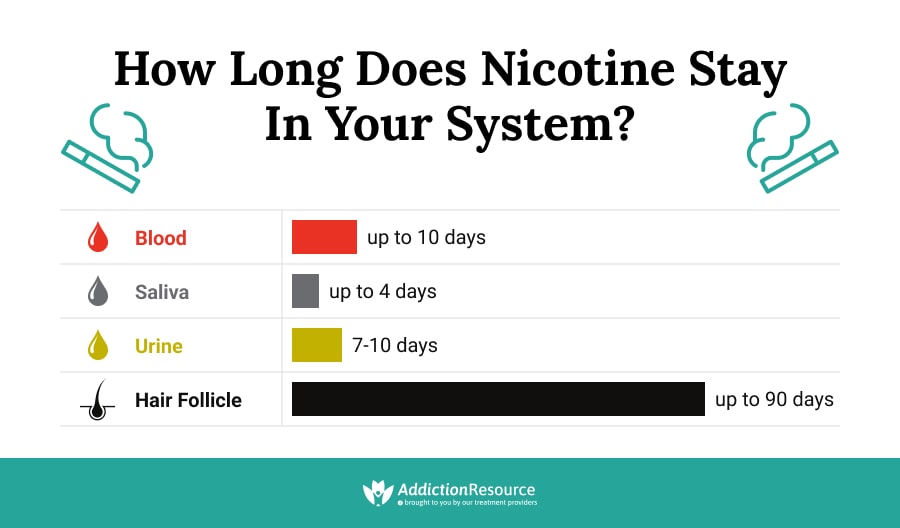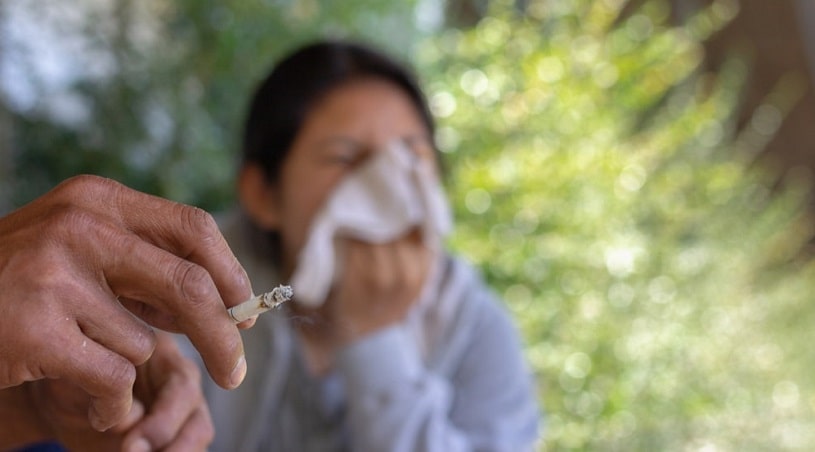
Nicotine, a major component in tobacco, is absorbed into the system when a person smokes a cigarette or chews tobacco. It is broken down to сotinine during metabolism. The amount of cotinine in the system is directly proportional to the amount and frequency of the substance ingested. The challenge of getting it out of your system fast will depend on various factors.
Table Of Contents:
Nicotine test is often a standard for employment and drug agencies. To pass these tests, there are many queries on how to get the substance out of your system before going for a test. How long does nicotine stay in your system? The answers can be found in nicotine half-life.
How Long Does Nicotine Stay In Your System?
After using tobacco, the by-products can be detected in one’s system at various periods. Even if one quits smoking, the components will still remain in the body for some time. Cotinine remains detectable in urine, saliva, hair, hair, blood, and nails. Let’s take a look at the various body samples and how long they can retain the drug.
How Long Does Cotinine Stay in Your Urine?
Urine samples are the most widely used for a nicotine drug test due to the time it takes for substances to be eliminated through urine. In addition, a research journal stated that urine retains 4-6 times more cotinine than saliva or blood; this is why a urine test is more accurate.
Cotinine levels peak at the end of smoke and begin to break down to continue. Cotinine leaves the urine within 7 to 10 days after the last smoke.
How Long Does Nicotine Stay in Your Blood System?
A blood test is an invasive form of measuring cotinine in the system and is often reliable. A blood nicotine test can also be used to check for exposure to tobacco smoke among non-smokers due to its accuracy.
The drug can be found in the bloodstream at least an hour after smoking or inhalation of the substance. It may take 10 days for cotinine to leave the blood after an individual quits.
Saliva
The saliva test is non-invasive and difficult to tamper with, so it is most accurate. Those who require means on how to cheat a nicotine test may find it challenging to alter a saliva test. Cotinine is retained in saliva for about 4 days after one quits smoking.
Hair
A hair test is rarely used compared to the others. Moreover, according to an NCBI study, there is a problem related to hair pigmentation, as it influences cotinine binding and uptake. These substances are bound to melanin; therefore, dark hair binds much more nicotine than does blond or white hair. However, the hair test is the most accurate for drug tests as it can retain drugs and other substances in hair for months.
A nicotine test will identify tobacco use in the hair within 90 days after inhalation. In some cases, it can be identified for as long as a year.

What Does Nicotine Do?
The drug enters the bloodstream when it’s chewed, smoked, or absorbed through the skin. It binds with nicotinic acetylcholine receptors, which are located in the brain and muscles. The nicotinic receptors are ionotropic and contain five heteromeric or homomeric subunits. It binds to acetylcholine receptors located on dopaminergic neurons and chromaffin cells of the brain.
The receptors on the dopaminergic neurons bind to this tobacco component to open the channel to enable the conductance of cations like potassium, calcium, and sodium. This action leads to depolarization, which triggers voltage-gated calcium channels and promotes calcium passage to the axon terminal. Meanwhile, calcium sparks vesicle trafficking and dopamine’s release into synapse.

Dopamine binds to its receptors to stimulate nicotine’s addictive properties. When the substance binds with nicotinic acetylcholine receptors on chromaffin cells, it opens ion channels that follow the same depolarization path to release epinephrine into the bloodstream. This causes an increase in blood pressure, blood sugar, heart rate, and vasoconstriction.
Nicotine Half-Life
The half-life of nicotine is defined as the time taken for half (50%) the amount of substance to be broken down and leave the body. The drug’s mechanism of action breaks down the substance and converts it to its secondary metabolite, cotinine. According to research, the half-life of cotinine is about 16 hours, and the nicotine half-life is about 2 to 3 hours.
The duration of time that it remains in the body depends on the amount consumed and nicotine half-life. Once the substance is eliminated from the body, nicotine withdrawal symptoms start.
Nicotine Test: What Should You Know About It?
A nicotine drug test is typically qualitative and quantitative; this is due to the fact that people break down drugs differently.
- Qualitative. This form of test is conducted to know if there are components of the drug in one’s body.
- Quantitative. This is a more comprehensive test conducted to understand the exact measure or concentration of cotinine and other secondary products in the body.
Using vaping products does not decrease the amount of tobacco consumption. Various nicotine drug test parameters determine the time taken for the substance to leave the body. Most drug tests use samples such as saliva, blood, urine, and hair to determine the concentration of the substance in the body, and various deductions can be made from the test results.
Such Deductions Include:
- Perpetual smoker
- Former smoker
- Average smoker
- Secondhand smoking
The drug’s classification as a narcotic and its effect on the CNS makes it a substance that is often tested in certain regions for employment and on a court order.
Factors That Affect Detection Windows
Generally, it is expected that the drug will exit the blood within 1-3 days, while cotinine will be cleared within 1-10 days, varying from one individual to the other. The amount of the substance in a cigarette may also influence these differences; however, there are more consistent factors that can alter the results of a nicotine drug test by affecting the detection window.
Some Of these Factors Include:
Frequency of Use
Individuals with a long history of tobacco use break down the drug slower than non-smokers. It means that the half-life of nicotine in a chain smoker may be much longer than in regular smokers.
Age
The speed of metabolism is also connected with age. The elderly would retain nicotine longer than the youths. Hence, it is easier to detect it in adults aged 60 and above rather than younger adults.
Type of Tobacco
Tobacco products may differ as some products introduce more of the substance into your system than others. Smokers who use hookah and bidi would have far lesser content in their blood than those who use cigarettes frequently.
Diet
It was discovered in 2005 by the American Society for Pharmacology and Environmental Therapeutics that the human diet played a significant role in reducing the percentage of the substance in the body. In some cases, a good amount of cotinine clears from the system after a meal.
Gender
It was found that the level of cotinine was reasonably lower in women than in men. It means that the substance cotinine breaks down faster in females than males. It was also found that pregnancy expedites its breakdown in the body even though the side effects of nicotine will be present in chain smokers.
Can Secondhand Smoke Affect Nicotine Test Results?
Secondhand smoking has been identified as a possible means of heart disease, breathing issues, and cancer. Exposure to secondhand smoking is dangerous and can easily be identified in non-smokers.

The presence of cotinine in the saliva, urine, and blood of non-smokers, even in its smallest quantity, is evident in secondhand smoking. The Center for Disease Control and Prevention stated that individuals who do not engage in any form of smoking might test positive for tobacco use through all liquid samples.
Staying Safe From Addiction
Smoking is a harmful habit, and tobacco compounds can be traced in the system long after use. The best way to avoid its presence in your system and a positive result on a nicotine test is to quit smoking. There are many ways to tackle tobacco addiction, including replacement therapy, behavioral tips, and rehab for smokers. Treatment options are available, and the addiction can be overcome. In general, smoking is dangerous to health and can lead to many short-term and long-term health problems, and even nicotine poisoning.
Quitting smoking may be challenging, but with determination and sufficient effort, it is still possible to live a smoking-free life.
Hope Without Commitment
Find the best treatment options. Call our free and confidential helpline
Most private insurances accepted
Find Drug Rehabilitation Centers Near You Anywhere In the US
Addiction Resource team has compiled an extensive list of the top drug rehabilitation facilities around the country. Use our locator tool to find the best centers near you.
Page Sources
- Cancer Control, Nicotine Effects and Addiction. https://cancercontrol.cancer.gov/brp/tcrb/monographs/2/m2_4.pdf
- Neal L. Benowitz, Pharmacology of Nicotine: Addiction, Smoking-Induced Disease, and Therapeutics, 2009. https://www.ncbi.nlm.nih.gov/pmc/articles/PMC2946180/
- Centers for Disease Control and Prevention, Biomonitoring Summary Cotinine, 2017. https://www.cdc.gov/biomonitoring/Cotinine_BiomonitoringSummary.html
- Neal L. Benowitz, Janne Hukkanen, and Peyton Jacob, III, Nicotine Chemistry, Metabolism, Kinetics and Biomarkers, 2010. https://www.ncbi.nlm.nih.gov/pmc/articles/PMC2953858/
- Mitali Raja, Aarti Garg, Pramod Yadav, Kunal Jha, and Sahil Handa, Diagnostic Methods for Detection of Cotinine Level in Tobacco Users: A Review, 2016. https://www.ncbi.nlm.nih.gov/pmc/articles/PMC4843405/
- Allshine Chen, Nicolle M. Krebs, Junjia Zhu, Dongxiao Sun, Andrea Stennett, and Joshua E. Muscat, Sex/Gender Differences in Cotinine Levels Among Daily Smokers in the Pennsylvania Adult Smoking Study, 2017. https://www.ncbi.nlm.nih.gov/pmc/articles/PMC5695730/
- Marieh Honarmand, Alireza Nakhaee, and Mohammad Moradi, Comparison of Salivary Cotinine Concentrations in Male Smokers and Smokeless Tobacco Users, 2018. https://www.ncbi.nlm.nih.gov/pmc/articles/PMC6031843/
- Neal L. Benowitz, Pharmacology of Nicotine: Addiction, Smoking-Induced Disease, and Therapeutics, 2010. https://www.ncbi.nlm.nih.gov/pmc/articles/PMC2946180/
- Centers for Disease Control and Prevention,Secondhand Smoke (SHS) Facts, 2018. https://www.cdc.gov/tobacco/data_statistics/fact_sheets/secondhand_smoke/general_facts/index.htm


 Reviewed by:
Reviewed by:  Written by:
Written by: 

 FindTreatment.gov
FindTreatment.gov